Moxifloxacin
- CAS No.
- 151096-09-2
- Chemical Name:
- Moxifloxacin
- Synonyms
- 1-Cyclopropyl-6-fluoro-8-methoxy-7-(octahydro-pyrrolo[3,4-b]pyridin-6-yl)-4-oxo-1,4-dihydro-quinoline-3-carboxylic acid;7-[(4aS,7aS)-octahydro-1H-pyrrolo[3,4-b]pyridin-6-yl]-1-cyclopropyl-6-fluoro-8-methoxy-4-oxo-1,4-dihydroquinoline-3-carboxylic acid;Avdox;CS-83;Aids070017;Aids-070017;MOXIFLOXACIN;MAXIOFFOXACIN;Moxifloxacin(Hclform);Moxifloxacin USP/EP/BP
- CBNumber:
- CB0191432
- Molecular Formula:
- C21H24FN3O4
- Molecular Weight:
- 401.43
- MDL Number:
- MFCD04117996
- MOL File:
- 151096-09-2.mol
- MSDS File:
- SDS
| Melting point | 203-208 C |
|---|---|
| alpha | 23D -193° |
| Boiling point | 636.4±55.0 °C(Predicted) |
| Density | 1.408±0.06 g/cm3(Predicted) |
| storage temp. | 2-8°C(protect from light) |
| solubility | Acetonitrile (Slightly), DMSO (Slightly, Heated, Sonicated), Methanol (Slightly) |
| pka | 6.43±0.50(Predicted) |
| form | Solid |
| color | Off-White to Light Yellow |
| Stability | Hygroscopic |
| CAS DataBase Reference | 151096-09-2(CAS DataBase Reference) |
| FDA UNII | U188XYD42P |
| ATC code | J01MA14,S01AE07 |
| EPA Substance Registry System | 3-Quinolinecarboxylic acid, 1-cyclopropyl-6-fluoro-1,4-dihydro-8-methoxy-7-[(4aS,7aS)-octahydro-6H-pyrrolo[3,4-b]pyridin-6-yl]-4-oxo- (151096-09-2) |
SAFETY
Risk and Safety Statements
| Symbol(GHS) |  GHS07 |
|---|---|
| Signal word | Warning |
| Hazard statements | H319-H302-H412 |
| Precautionary statements | P273-P501-P264-P280-P305+P351+P338-P337+P313P-P264-P270-P301+P312-P330-P501 |
| Hazard Codes | Xn |
| Risk Statements | 22-40 |
| Safety Statements | 36/37 |
Moxifloxacin price More Price(24)
| Manufacturer | Product number | Product description | CAS number | Packaging | Price | Updated | Buy |
|---|---|---|---|---|---|---|---|
| ApexBio Technology | B1218 | Moxifloxacin | 151096-09-2 | 50mg | $50 | 2021-12-16 | Buy |
| AK Scientific | E111 | Moxifloxacin | 151096-09-2 | 25g | $217 | 2021-12-16 | Buy |
| Biorbyt Ltd | orb611887 | Moxifloxacin >98% | 151096-09-2 | 100mg | $277.1 | 2021-12-16 | Buy |
| ApexBio Technology | B1218 | Moxifloxacin | 151096-09-2 | 200mg | $150 | 2021-12-16 | Buy |
| Biorbyt Ltd | orb611887 | Moxifloxacin >98% | 151096-09-2 | 500mg | $414.8 | 2021-12-16 | Buy |
Moxifloxacin Chemical Properties,Uses,Production
Description
Moxifloxacin is a fourth-generation synthetic fluoroquinolone antibacterial agent developed by Bayer AG (initially called BAY 12-8039), used to treat a number of infections, including: respiratory tract infections, cellulitis, anthrax, intraabdominal infections, endocarditis, meningitis, and tuberculosis. It is marketed worldwide (as the hydrochloride) under the brand names Avelox, Avalox, and Avelon for oral treatment. In most countries, the drug is also available in parenteral form for intravenous infusion.
In the United States, moxifloxacin is licensed for the treatment of acute bacterial sinusitis, acute bacterial exacerbation of chronic bronchitis, community acquired pneumonia, complicated and uncomplicated skin and skin structure infections, and complicated intra-abdominal infections.[5] In the European Union, it is licensed for acute bacterial exacerbations of chronic bronchitis, non-severe community-acquired pneumonia, and acute bacterial sinusitis.
Brand Name(s) in US
Avelox
Quinolones
Moxifloxacin and levofloxacin, gatifloxacin, gemifloxacin are quinolone antibacterial drugs newly developed in recent years. The position of C-7 ring structure of the nitrogen enhances antibacterial effect of gram positive bacteria, and methoxy strengthens the role of anaerobic bacteria. Such new varieties significantly increased excellent antibacterial activity against Streptococcus pneumoniae and other respiratory tract infections common pathogens antibacterial activity. Penicillin-resistant Streptococcus pneumoniae, Haemophilus influenzae, Moraxella catarrhal and Mycoplasma pneumoniae, Chlamydia pneumoniae Atypical pathogens, also known as "quinolones breathing". Moxifloxacin has bactericidal effect by interfering Ⅱ, Ⅳ topoisomerase. It also has strong antibacterial effect on gram-positive bacteria, Gram-negative bacteria, anaerobic bacteria, Mycoplasma pneumoniae, Chlamydia pneumoniae and Legionella bacteria. It has no cross-resistance situation between penicillins, cephalosporins, glycopeptides, macrolides, tetracyclines and other antibiotics. Bactericidal activity of moxifloxacin is similar with isoniazid, and is better than levofloxacin to rapid growth of Mycobacterium tuberculosis, as well as it is slightly lower than levofloxacin to quiescent Mycobacterium tuberculosis. It is for the treatment of acute bronchitis, chronic obstructive pulmonary disease exacerbations, community acquired pneumonia and bronchiectasis. General oral 400mg/times, 1 times/d; the course is 5 to 7 days. Adverse reactions are nausea, upset stomach and abdominal pain. The quinolones allergies, pregnant women, breastfeeding women and children should not use it.
Mechanism of action
Moxifloxacin mechanism is mainly inhibition of bacterial DNA synthesis, since rapid bactericidal effect, which can act on bacterial DNA gyrase and topoisomerase Ⅳ, resulting in breakage enzyme-DNA complex. DNA gyrase, also known as topoisomerase Ⅱ, composed of the gyrA, gyrB subunit. DNA gyrase and topoisomerase Ⅰ common regulate DNA replication. Throughout the replication process, DNA gyrase mainly have the effect of the maintenance of DNA coiled modest role. Topoisomerase Ⅳ is composed of the parC and parE subunits. Its structure and DNA gyrase have similarities, which parC and gyrA, parE and gyrB have some homology. Topoisomerase Ⅳ can copy the complete distribution of progeny DNA to progeny cells, together with DNA gyrase to complete bacterial DNA replication. Moxifloxacin enzyme-DNA complexes can be stable in the DNA chain cut off state, terminating the DNA replication, resulting in a cytotoxic effect. Moxifloxacin on site is the main function of most gram-negative bacteria DNA gyrase, and effect on gram-positive bacteria loci with topoisomerase Ⅳ primarily.
Preparation
1-cyclopropyl-6, 7-difluoro-1, 4-dihydro-8-methoxy-4-oxo-3-quinolinecarboxylic acid was dissolved in acetonitrile and dimethylformamide, and then added 1,4-diazabicyclo [2.2.2] octane and the (+)-[S, S]-2,8-diazabicyclo [4.3.0] nonane, refluxed for 1h. Cooling, precipitate was obtained by filtering, and washed with water. Stirring together with water for a moment, filtered and dried. The residue was purified by silica gel chromatography, dichloromethane/methanol/17% aqueous ammonia = 30: 8: 1 start, and moxifloxacin was obtained, melting point 203~208 ℃.
Adverse effects
- Moxifloxacin is associated with an increased risk of tendon problems. These include pain, swelling, inflammation, and possible breakage of tendons. Moxifloxacin may worsen muscle weakness and breathing problems in patients with myasthenia gravis. Do not use moxifloxacin if you have a history of myasthenia gravis.
- Rare but serious adverse effects that may occur as a result of moxifloxacin therapy include irreversible peripheral neuropathy, spontaneous tendon rupture and tendonitis, hepatitis, psychiatric effects (hallucinations, depression), torsades de pointes, Stevens-Johnson syndrome and Clostridium difficile-associated disease, and photosensitivity/phototoxicity reactions.
References
https://en.wikipedia.org/wiki/Moxifloxacin
https://www.drugs.com/cdi/moxifloxacin.html
Originator
Avelox,Bayer
Uses
Moxifloxacin is an antibiotic for the treatment of bacterial infections like bacterial sinusitis, acute bacterial exacerbations of chronic bronchitis, and community-acquired pneumonia.
Definition
ChEBI: A quinolone that consits of 4-oxo-1,4-dihydroquinoline-3-carboxylic acid bearing a cyclopropyl substituent at position 1, a fluoro substitiuent at position 6, a (4aS,7aS)-octahydro-6H-pyrrolo[3,4-b /ital>]pyridin-6-yl group at position 7 and a methoxy substituent at position 8. A member of the fluoroquinolone class of antibacterial agents.
Therapeutic Function
Antibacterial
Antimicrobial activity
It displays good activity in vitro against Enterobacteriaceae and fastidious Gram-negative bacilli such as H. influenzae and Mor. catarrhalis, as well as against Grampositive cocci including Str. pneumoniae, but is poorly active against Enterococcus spp. Activity against non-fermentative Gramnegative bacilli is species dependent: Acinetobacter spp. (MIC 0.006–2.0 mg/L) and Sten. maltophilia (MIC 0.5–2.0 mg/L) are partially susceptible in vitro, but it has poor activity against Ps. aeruginosa and other non-fermenting Gram-negative rods. It displays good in-vitro activity against Ch. pneumoniae, C. trachomatis, mycoplasmas (including M. pneumoniae), L. pneumophila and B. fragilis. Although highly active against M. tuberculosis, it is less active against the M. avium complex, M. intracellulare, M. chelonei and M. fortuitum.
Pharmaceutical Applications
fluoroquinolone substituted with an 8-methoxy group and a 7-diazabicyclononyl moiety, formulated as the hydrochloride for oral or intravenous use.
Biological Activity
moxifloxacin is an orally bio-available, broad spectrum bacterial gyrase-inhibiting fluoroquinolone antibiotic [1].moxifloxacin at 50 μg/ml has been reported to induce a significant reduction of viable cells. a remarkable anti-proliferative activity of moxifloxacin has been proved in the concentrations between 50 and 1500 μg/ml. moreover, moxifloxacin could lead to signs of cellular damage which were seen like binucleation in a dose-dependent manner [2].rats intravenously injected with moxifloxacin at 100 mg/kg have shown the increase of serum glucose and serum epinephrine concentrations as well as the release of histamine. however, moxifloxacin at 75 mg/kg did not show any effects on serum epinephrine, glucose or histamine concentrations increase [3].
Pharmacokinetics
absorption and distribution
By the oral route, drug uptake is rapid, with moderate variability. As with all quinolones iron and antacids significantly reduce the bioavailability. No significant drug interactions with theophylline, itraconazole, probenecid or oral contraceptives have been found. In escalating dose studies (50–80 mg doses), Cmax and AUC values increased proportionally to the dose.
It is widely distributed throughout the body and into many tissues in concentrations exceeding those in plasma. Around 50–80% of plasma concentrations penetrate into CSF if the meninges are inflamed. The apparent plasma half-life is 15.6 h.
Metabolism and excretion
Biliary elimination and metabolism are the main elimination pathways. About 19.3% of the administered dose is eliminated in the urine, with a bioavailability of 86.2%. Urinary excretion is via glomerular filtration and tubular reabsorption. Two main metabolites are recovered: M1 (a sulfocompound) and M2 (a glucuronide). M1 is mainly eliminated in feces (34.4%) and only 2.5% in urine: M2 is eliminated in urine (13.8%).
Clinical Use
Acute bacterial exacerbations of chronic bronchitis and community
acquired pneumonia
Acute bacterial sinusitis
Treatment of complicated skin and soft-tissue infections caused by methicillin-susceptible Staph. aureus and Gram-negative rods (i.v. formulation)
Treatment of complicated intra-abdominal infections (i.v. formulation)
Side effects
Adverse events are similar to those for other fluoroquinolones. Phototoxicity rates are not significantly above placebo levels. Gastrointestinal side effects are the most common, particularly nausea, diarrhea, abdominal pain and vomiting. Dizziness and headache may occur as well as allergic reactions. Attention has been drawn to a potential to cause lifethreatening hepatotoxicity. Moxifloxacin has the potential to prolong the QTc interval in some patients but the clinical significance of this phenomenon is unclear.
Drug interactions
Potentially hazardous interactions with other drugs
Aminophylline and theophylline: possibly increased
risk of convulsions.
Analgesics: increased risk of convulsions with
NSAIDs.
Anti-arrhythmics: increased risk of ventricular
arrhythmias with amiodarone, disopyramide and
procainamide - avoid Antibacterials: increased risk of ventricular
arrhythmias with parenteral erythromycin - avoid;
increased risk of ventricular arrhythmias with
delamanid and telithromycin.
Anticoagulants: anticoagulant effect enhanced.
Antidepressants: increased risk of ventricular
arrhythmias with tricyclics, citalopram, escitalopram
and venlafaxine - avoid.
Antihistamines: increased risk of ventricular
arrhythmias with mizolastine - avoid.
Antimalarials: increased risk of ventricular
arrhythmias with chloroquine, hydroxychloroquine,
mefloquine or quinine - avoid; avoid with
artemether with lumefantrine and piperaquine with
artenimol.
Antipsychotics: increased risk of ventricular
arrhythmias with benperidol, droperidol, haloperidol,
phenothiazines, pimozide or zuclopenthixol - avoid.
Antivirals: increased risk of ventricular arrhythmias
with saquinavir - avoid.
Atomoxetine: increased risk of ventricular
arrhythmias - avoid.
Beta-blockers: increased risk of ventricular
arrhythmias with sotalol - avoid.
Ciclosporin: some reports of increased
nephrotoxicity.
Cytotoxics: increased risk of ventricular
arrhythmias with arsenic trioxide, bosutinib,
ceritinib, panobinostat and vandetanib, avoid with
panobinostat and vandetanib.
Pentamidine: increased risk of ventricular
arrhythmias - avoid.
Metabolism
Metabolised mainly via sulphate and glucuronide conjugation, and is excreted in the urine and the faeces as unchanged drug and as metabolites, the sulphate conjugate mainly in the faeces and the glucuronide exclusively in the urine.
References
[1] iatropoulos mj1, jeffrey am, enzmann hg, von keutz e, schlueter g, williams gm. assessment of chronic toxicity and carcinogenicity in an accelerated cancer bioassay in rats of moxifloxacin, a quinolone antibiotic. exp toxicol pathol. 2001 oct;53(5):345-57.
[2] sobolewska b1, hofmann j, spitzer ms, bartz-schmidt ku, szurman p, yoeruek e. antiproliferative and cytotoxic properties of moxifloxacin on rat retinal ganglion cells. curr eye res. 2013 jun;38(6):662-9.
[3] ishiwata y1, takahashi y, nagata m, yasuhara m. effects of moxifloxacin on serum glucose concentrations in rats. biol pharm bull. 2013;36(4):686-90.
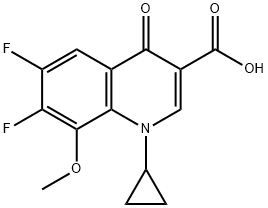
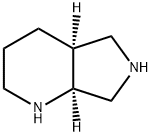
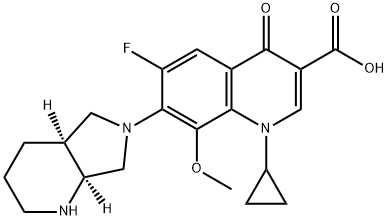
Moxifloxacin Preparation Products And Raw materials
Raw materials
1of5
Preparation Products
| Supplier | Tel | Country | ProdList | Advantage | |
|---|---|---|---|---|---|
| Henan Tianfu Chemical Co.,Ltd. | +86-0371-55170693 +86-19937530512 | info@tianfuchem.com | China | 21691 | 55 |
| ATK CHEMICAL COMPANY LIMITED | +undefined-21-51877795 | ivan@atkchemical.com | China | 32480 | 60 |
| career henan chemical co | +86-0371-86658258 | sales@coreychem.com | China | 29914 | 58 |
| Biochempartner | 0086-13720134139 | candy@biochempartner.com | CHINA | 967 | 58 |
| Hubei Jusheng Technology Co.,Ltd. | 18871490254 | linda@hubeijusheng.com | CHINA | 28180 | 58 |
| Wuhan Chemwonders Technology Inc. | 027-85778276 | info@chemwonders.com | CHINA | 176 | 58 |
| Xiamen AmoyChem Co., Ltd | +86-592-6051114 +8618959220845 | sales@amoychem.com | China | 6387 | 58 |
| Chongqing Chemdad Co., Ltd | +86-023-61398051 +8613650506873 | sales@chemdad.com | China | 39916 | 58 |
| Alchem Pharmtech,Inc. | 8485655694 | sales@alchempharmtech.com | United States | 63711 | 58 |
| CONIER CHEM AND PHARMA LIMITED | +8618523575427 | sales@conier.com | China | 49390 | 58 |
Related articles
- Toxicity of Moxifloxacin
- Moxifloxacin (Bay 12-8039) is a fourth-generation synthetic fluoroquinolone developed by Bayer Pharmaceuticals in the early 19....
- Mar 15,2022
View Lastest Price from Moxifloxacin manufacturers
| Image | Update time | Product | Price | Min. Order | Purity | Supply Ability | Manufacturer | |
|---|---|---|---|---|---|---|---|---|
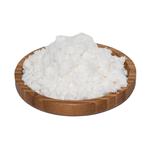 |
2023-06-26 | Moxifloxacin
151096-09-2
|
US $200.00 / kg | 1kg | 99% | 1000kg/Months | Hebei Mingeng Biotechnology Co., Ltd | |
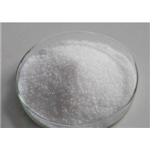 |
2023-04-12 | Moxifloxacin
151096-09-2
|
US $1.00 / KG | 1KG | 99.37% HPLC | 5000tons/year | Wuhan Dujiang Industrial Co., Ltd. | |
 |
2023-03-06 | Moxifloxacin
151096-09-2
|
US $1.90 / KG | 1KG | 99% | 10 ton | Hebei Guanlang Biotechnology Co,.LTD |
-

- Moxifloxacin
151096-09-2
- US $200.00 / kg
- 99%
- Hebei Mingeng Biotechnology Co., Ltd
-

- Moxifloxacin
151096-09-2
- US $1.00 / KG
- 99.37% HPLC
- Wuhan Dujiang Industrial Co., Ltd.
-

- Moxifloxacin
151096-09-2
- US $1.90 / KG
- 99%
- Hebei Guanlang Biotechnology Co,.LTD





